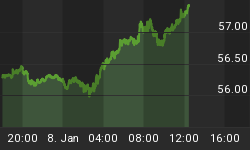Defense giant Lockheed Martin Corp’s (NYSE:LMT) shares closed up Monday 17 percent and continued to climb after hours and into Tuesday, briefly hitting $319 following the news of a $480-million contract with the Pentagon.

(Click to enlarge)
Under the contract, Lockheed will provide the Pentagon with air-launched rapid response weapon critical design review and test and production readiness support.
But it’s not just this latest Pentagon contract that has investors bullish: Lockheed is expecting to post positive (32.1-percent) year-over-year growth in its next quarterly earnings results due out in late October, and the aerospace-defense sectors are pinging investor radar all around.
There’s nothing like a looming trade war to raise global tensions to the point of lucrative defense budgets.
Indeed, the Pentagon’s most recent budget proposals signal a spending spree on the part of the Department of Defense—and it’s not confined to the United States, either.
Aerospace is also in a boom cycle, with aircraft production soaring on global air traffic demand.
But Trump’s steel and aluminum tariffs could throw a spanner in the works, particularly for the U.S., which relies heavily on foreign supplies that will be more expensive, both in terms of tariffs costs and the potential supply-chain disruption. Related: Goldman: Netflix Is Set To Soar
Will it be enough to derail the momentum of stocks like Lockheed Martin? Maybe, but it might be offset by the major uptick in global spending on both aerospace and defense.
The growth outlook for all three components of the aerospace and defense industry—commercial aircraft, defense systems, space systems—is attractive.
The commercial aircraft market is expected to equal a $15-trillion opportunity over the next two decades, with Boeing cornered 45 percent of the market share.
For U.S. defense, we’re looking at a budget increase of 7.4 percent next year—the highest since 2011 (think, Iraq), as Washington sets out to procure new high-tech weapons systems. We don’t need an actual war—just the specter of one, in tried and true Cold War fashion.
And let’s not forget the space segment, which is decidedly smaller, but growing at a fast clip of 6 percent annually, with the global space market set to grow to $560 billion in 2026. Right now, this market is valued at $360 million with investment demand driven most notably by nano-satellites and re-usable launch vehicle systems, as well as the development of next-gen satellite systems and their large-scale procurement.
Related: Investors Flee Emerging Markets Amid Lira Crisis
Indeed, according to PwC, M&A value in the global aerospace and defense industry reached $24.2 billion during the first half of this year—a 30-percent uptick from the same period last year. Even though the number of deals has dropped 17 percent, the average deal size is 50-percent bigger, with General Dynamics (NYSE:GD) acquiring CSRA for $9.7 billion and Boeing announcing plans in May to KLX parts and services provider for $4.2 billion.
So if there are still any defense bears out there who say companies like Lockheed aren’t going anywhere fast and that tariffs will nip at the heels of their growth, the bulls will disagree. This sector might just be strong enough to weather tariffs, and PwC sees plenty of deal-making still coming down the pipeline:
“We believe the factors impacting commercial aerospace and defense, as well as the industry’s liquidity position, bode well for continued strength in deal making,” said Bob Long, U.S. aerospace and defense deals leader at PwC.
By Fred Dunkley for Safehaven.com
More Top Reads From Safehaven.com:

















